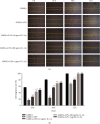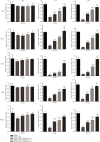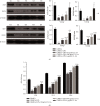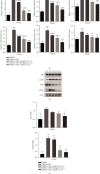IL-1 Receptor Antagonist Protects the Osteogenesis Capability of Gingival-Derived Stem/Progenitor Cells under Inflammatory Microenvironment Induced by Porphyromonas gingivalis Lipopolysaccharides
- PMID: 33531908
- PMCID: PMC7834827
- DOI: 10.1155/2021/6638575
IL-1 Receptor Antagonist Protects the Osteogenesis Capability of Gingival-Derived Stem/Progenitor Cells under Inflammatory Microenvironment Induced by Porphyromonas gingivalis Lipopolysaccharides
Abstract
Mesenchymal stem cells (MSCs) have been considered to be a future treatment option for periodontitis due to their excellent regenerative capability. However, it is still a challenge to protect MSCs' biological properties from multiple bacterial toxins in local inflammatory environment. The present study is aimed at investigating the treatment effect of interleukin-1 receptor antagonist (IL-1ra) on cell proliferation, migration, and osteogenic differentiation of gingival-derived mesenchymal stem cells (GMSCs) under an inflammatory microenvironment induced by Porphyromonas gingivalis lipopolysaccharides (P. gingivalis-LPS). GMSCs derived from Sprague-Dawley (SD) rats' free gingival tissues were treated with P. gingivalis-LPS (10 μg/mL) to create in vitro inflammatory environment. Different concentrations of IL-1ra (0.01-1 μg/mL) were used to antagonize the negative effect of LPS. Cell behaviors including proliferation, cloning formation unit (CFU), cell migration, osteogenic differentiation, mineral deposition, and cytokine production were assessed to investigate the protection effect of IL-1ra on GMSCs under inflammation. The toll-like receptor 4 (TLR4)/nuclear factor kappa B (NF-κB) pathway activated by LPS was evaluated by real-time quantitative polymerase chain reaction (RT-PCR) and western blot. In response to P. gingivalis-LPS treatment, cell numbers, cloning formation rate, cell migration rate, proinflammatory cytokine production, and osteogenic differentiation-associated protein/mRNA expressions as well as mineralized nodules were suppressed in a time-dependent manner. These negative effects were effectively attenuated by IL-1ra administration in a time- and dose-dependent manner. In addition, mRNA expressions of TLR4 and IkBα decreased dramatically when IL-1ra was added into LPS-induced medium. IL-1ra also reversed the LPS-induced TLR4/NF-κB activation as indicated by western blot. The present study revealed that IL-1ra decreased inflammatory cytokine production in a supernatant, so as to protect GMSCs' osteogenesis capacity and other biological properties under P. gingivalis-LPS-induced inflammatory environment. This might be explained by IL-1ra downregulating TLR4-mediated NF-κB signaling pathway activation.
Copyright © 2021 Yuxin Zhao et al.
Conflict of interest statement
The authors declare no conflict of interest regarding the publication of this article.
Figures










Similar articles
-
Quercetin Inhibits Inflammatory Response Induced by LPS from Porphyromonas gingivalis in Human Gingival Fibroblasts via Suppressing NF-κB Signaling Pathway.Biomed Res Int. 2019 Aug 20;2019:6282635. doi: 10.1155/2019/6282635. eCollection 2019. Biomed Res Int. 2019. PMID: 31531360 Free PMC article.
-
Porphyromonas gingivalis lipopolysaccharide induces cognitive dysfunction, mediated by neuronal inflammation via activation of the TLR4 signaling pathway in C57BL/6 mice.J Neuroinflammation. 2018 Feb 9;15(1):37. doi: 10.1186/s12974-017-1052-x. J Neuroinflammation. 2018. PMID: 29426327 Free PMC article.
-
Rho-kinase inhibitor Y-27632 downregulates LPS-induced IL-6 and IL-8 production via blocking p38 MAPK and NF-κB pathways in human gingival fibroblasts.J Periodontol. 2018 Jul;89(7):883-893. doi: 10.1002/JPER.17-0571. J Periodontol. 2018. PMID: 29630729
-
Porphyromonas gingivalis lipopolysaccharide signaling in gingival fibroblasts-CD14 and Toll-like receptors.Crit Rev Oral Biol Med. 2002;13(2):132-42. doi: 10.1177/154411130201300204. Crit Rev Oral Biol Med. 2002. PMID: 12097356 Review.
-
The Effects of Porphyromonas gingivalis on Inflammatory and Immune Responses and Osteogenesis of Mesenchymal Stem Cells.Stem Cells Dev. 2021 Dec 15;30(24):1191-1201. doi: 10.1089/scd.2021.0068. Epub 2021 Nov 13. Stem Cells Dev. 2021. PMID: 34628938 Review.
Cited by
-
Molecular Basis beyond Interrelated Bone Resorption/Regeneration in Periodontal Diseases: A Concise Review.Int J Mol Sci. 2023 Feb 27;24(5):4599. doi: 10.3390/ijms24054599. Int J Mol Sci. 2023. PMID: 36902030 Free PMC article. Review.
-
Inhibition of lipopolysaccharide-induced NF-κB maintains osteogenesis of dental pulp and periodontal ligament stem cells.Braz Oral Res. 2024 May 13;38:e037. doi: 10.1590/1807-3107bor-2024.vol38.0037. eCollection 2024. Braz Oral Res. 2024. PMID: 38747824 Free PMC article.
-
Retrospective Case-Control Study Genes Related to Bone Metabolism That Justify the Condition of Periodontal Disease and Failure of Dental Implants in Patients with down Syndrome.Int J Mol Sci. 2023 Apr 23;24(9):7723. doi: 10.3390/ijms24097723. Int J Mol Sci. 2023. PMID: 37175429 Free PMC article.
-
IL-1 Receptor Antagonist Anakinra Inhibits the Effect of IL-1β- Mediated Osteoclast Formation by Periodontal Ligament Fibroblasts.Biology (Basel). 2025 Feb 28;14(3):250. doi: 10.3390/biology14030250. Biology (Basel). 2025. PMID: 40136507 Free PMC article.
-
From mitochondria to immune networks: new mesenchymal stem cell strategies to treat periodontitis.Stem Cell Res Ther. 2025 Aug 29;16(1):470. doi: 10.1186/s13287-025-04619-5. Stem Cell Res Ther. 2025. PMID: 40877977 Free PMC article. Review.
References
LinkOut - more resources
Full Text Sources
Other Literature Sources

